Recent Developments in the Use of Covalent Organic Frameworks for Photocatalytic Water Decontamination
Abstract
1. Introduction
2. Structure–Activity Relationships
2.1. Donor–Acceptor
2.2. Conjugation Tunning
2.3. Bandgap Modulation and Band Positioning for Optimal Photocatalysis
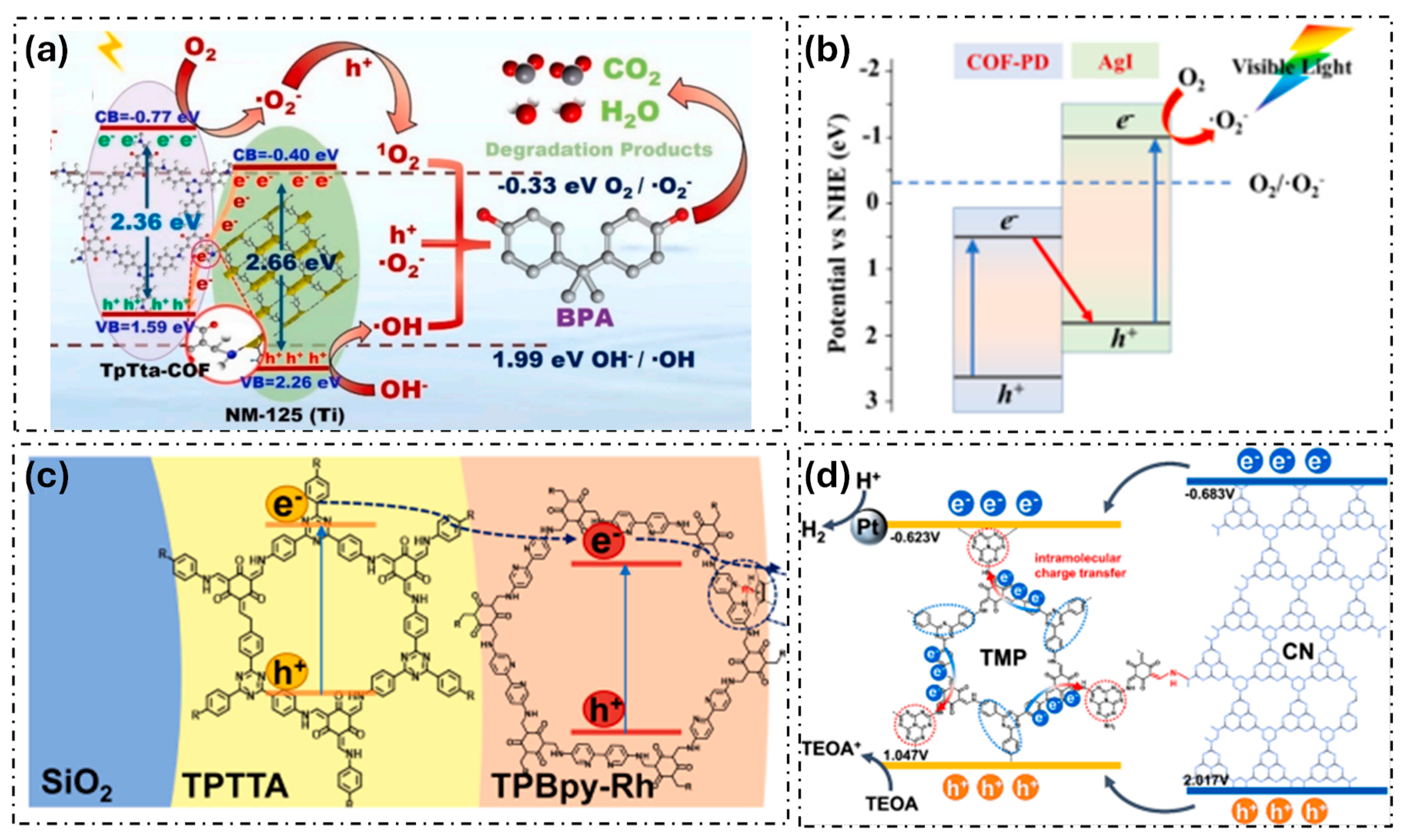
2.4. Synergistic Strategies
3. General Photocatalytic Mechanisms
3.1. Electron Transfer: Reductive Quenching vs. Oxidative Quenching
3.2. Generation of Radical Species: Superoxide, Hydroxyl, and Organic Radicals
3.3. Energy Transfer: Singlet Oxygen and Direct Energy Transfer
4. Pollutants Tackled
5. Concluding Remarks
Funding
Institutional Review Board Statement
Data Availability Statement
Conflicts of Interest
Abbreviations
| COF | Covalent Organic Frameworks |
| ROS | Reactive Oxygen Species |
| VB | Valence Band |
| CB | Conduction Band |
| ISC | Intersystem Crossing |
| EIS | Electrochemical Impedance Spectroscopy |
| XPS | X-ray Photoelectron Spectroscopy |
| UPS | Ultraviolet Photoelectron Spectroscopy |
| D-A | Donor–Acceptor |
| BPA | Bisphenol A |
| MOFs | Metal–Organic Frameworks |
| Vfb | Flat Band Potential |
| Ef | Fermi Level |
| HOMO | Highest Occupied Molecular Orbital |
| LUMO | Lowest Unoccupied Molecular Orbital |
| SET | Single Electron Transfer |
| EnT | Energy Transfer |
| PC | Photocatalyst |
| SED | Sacrificial Electron Donor |
| FRET | Förster Resonance Energy Transfer |
| Ered | Reduction Potential |
| Eox | Oxidation Potential |
| EPR | Electron Paramagnetic Resonance |
| TC | Tetracycline |
| ACTP | Acetaminophen |
| SMT | Sulfamethazine |
| SMX | Sulfamethoxazole |
| RhB | Rhodamine B |
| MB | Methylene Blue |
| MO | Methyl Orange |
| MB17 | Mordant Black 17 |
| EBA | Eriochrome Black A |
| EBT | Eriochrome Black T |
| RB | Rose Bengal |
| MG | Methyl Green |
References
- World Bank Group. Water. Available online: https://www.worldbank.org/en/topic/water/overview (accessed on 22 September 2024).
- Semrany, S.; Favier, L.; Djelal, H.; Taha, S.; Amrane, A. Bioaugmentation: Possible Solution in the Treatment of Bio-Refractory Organic Compounds (Bio-ROCs). Biochem. Eng. J. 2012, 69, 75–86. [Google Scholar] [CrossRef]
- Samarasinghe, L.V.; Muthukumaran, S.; Baskaran, K. Recent Advances in Visible Light-Activated Photocatalysts for Degradation of Dyes: A Comprehensive Review. Chemosphere 2024, 349, 140818. [Google Scholar] [CrossRef] [PubMed]
- Islam, M.; Kumar, S.; Saxena, N.; Nafees, A. Photocatalytic Degradation of Dyes Present in Industrial Effluents: A Review. ChemistrySelect 2023, 8, e202301048. [Google Scholar] [CrossRef]
- Ruziwa, D.T.; Oluwalana, A.E.; Mupa, M.; Meili, L.; Selvasembian, R.; Nindi, M.M.; Sillanpaa, M.; Gwenzi, W.; Chaukura, N. Pharmaceuticals in Wastewater and Their Photocatalytic Degradation Using Nano-Enabled Photocatalysts. J. Water Process Eng. 2023, 54, 103880. [Google Scholar] [CrossRef]
- Vaya, D.; Surolia, P.K. Semiconductor Based Photocatalytic Degradation of Pesticides: An Overview. Environ. Technol. Innov. 2020, 20, 101128. [Google Scholar] [CrossRef]
- Shoneye, A.; Sen Chang, J.; Chong, M.N.; Tang, J. Recent Progress in Photocatalytic Degradation of Chlorinated Phenols and Reduction of Heavy Metal Ions in Water by TiO2-Based Catalysts. Int. Mater. Rev. 2022, 67, 47–64. [Google Scholar] [CrossRef]
- Arora, R. Adsorption of Heavy Metals—A Review. Mater. Today Proc. 2019, 18, 4745–4750. [Google Scholar] [CrossRef]
- Okoli, B.J.; Modise, J.S. Sequestration of Pb(II) and Cr(VI) from Aqueous Environment Using Low-Cost Immobilised Tannin Resin. SN Appl. Sci. 2019, 1, 194. [Google Scholar] [CrossRef]
- Chu, C.; Ryberg, E.C.; Loeb, S.K.; Suh, M.-J.; Kim, J.-H. Water Disinfection in Rural Areas Demands Unconventional Solar Technologies. Acc. Chem. Res. 2019, 52, 1187–1195. [Google Scholar] [CrossRef]
- Joseph, L.; Jun, B.-M.; Flora, J.R.V.; Park, C.M.; Yoon, Y. Removal of Heavy Metals from Water Sources in the Developing World Using Low-Cost Materials: A Review. Chemosphere 2019, 229, 142–159. [Google Scholar] [CrossRef]
- Younis, S.A.; Kim, K.-H. Heterogeneous Photocatalysis Scalability for Environmental Remediation: Opportunities and Challenges. Catalysts 2020, 10, 1109. [Google Scholar] [CrossRef]
- Gaya, U.I.; Abdullah, A.H. Heterogeneous Photocatalytic Degradation of Organic Contaminants over Titanium Dioxide: A Review of Fundamentals, Progress and Problems. J. Photochem. Photobiol. C Photochem. Rev. 2008, 9, 1–12. [Google Scholar] [CrossRef]
- Moya, A.; Cherevan, A.; Marchesan, S.; Gebhardt, P.; Prato, M.; Eder, D.; Vilatela, J.J. Oxygen Vacancies and Interfaces Enhancing Photocatalytic Hydrogen Production in Mesoporous CNT/TiO2 Hybrids. Appl. Catal. B Environ. 2015, 179, 574–582. [Google Scholar] [CrossRef]
- Bagheri, S.; TermehYousefi, A.; Do, T.-O. Photocatalytic Pathway toward Degradation of Environmental Pharmaceutical Pollutants: Structure, Kinetics and Mechanism Approach. Catal. Sci. Technol. 2017, 7, 4548–4569. [Google Scholar] [CrossRef]
- Armaković, S.J.; Savanović, M.M.; Armaković, S. Spray-Deposited TiO2 Layers on Aluminum Foil for Sustainable Water Remediation. Crystals 2024, 14, 875. [Google Scholar] [CrossRef]
- Côté, A.P.; Benin, A.I.; Ockwig, N.W.; O’Keeffe, M.; Matzger, A.J.; Yaghi, O.M. Porous, Crystalline, Covalent Organic Frameworks. Science 2005, 310, 1166–1170. [Google Scholar] [CrossRef]
- López-Magano, A.; Jiménez-Almarza, A.; Alemán, J.; Mas-Ballesté, R. Metal–Organic Frameworks (MOFs) and Covalent Organic Frameworks (COFs) Applied to Photocatalytic Organic Transformations. Catalysts 2020, 10, 720. [Google Scholar] [CrossRef]
- López-Magano, A.; Salaverri, N.; Marzo, L.; Mas-Ballesté, R.; Alemán, J. Synergistic Combination of Triazine and Phenanthroline Moieties in a Covalent Triazine Framework Tailored for Heterogeneous Photocatalytic Metal-Free C-Br and C-Cl Activation. Appl. Catal. B Environ. 2022, 317, 121791. [Google Scholar] [CrossRef]
- Liu, F.; Ma, Z.; Deng, Y.; Wang, M.; Zhou, P.; Liu, W.; Guo, S.; Tong, M.; Ma, D. Tunable Covalent Organic Frameworks with Different Heterocyclic Nitrogen Locations for Efficient Cr(VI) Reduction, Escherichia Coli Disinfection, and Paracetamol Degradation under Visible-Light Irradiation. Environ. Sci. Technol. 2021, 55, 5371–5381. [Google Scholar] [CrossRef]
- Fávaro, M.A.; Yang, J.; Ditz, D.; Küçükkeçeci, H.; Alkhurisi, M.H.; Bergwinkl, S.; Thomas, A.; Quadrelli, E.A.; Palkovits, R.; Canivet, J.; et al. Pyrene- and Bipyridine-Based Covalent Triazine Framework as Versatile Platform for Photocatalytic Solar Fuels Production. ChemCatChem 2023, 15, e202300197. [Google Scholar] [CrossRef]
- Zhao, J.; Ren, J.; Zhang, G.; Zhao, Z.; Liu, S.; Zhang, W.; Chen, L. Donor-Acceptor Type Covalent Organic Frameworks. Chem. A Eur. J. 2021, 27, 10781–10797. [Google Scholar] [CrossRef] [PubMed]
- Wang, L.; Zhu, W. Organic Donor-Acceptor Systems for Photocatalysis. Adv. Sci. 2024, 11, 2307227. [Google Scholar] [CrossRef] [PubMed]
- Chen, W.; Wang, L.; Mo, D.; He, F.; Wen, Z.; Wu, X.; Xu, H.; Chen, L. Modulating Benzothiadiazole-Based Covalent Organic Frameworks via Halogenation for Enhanced Photocatalytic Water Splitting. Angew. Chem. Int. Ed. 2020, 59, 16902–16909. [Google Scholar] [CrossRef]
- Li, S.; Li, L.; Li, Y.; Dai, L.; Liu, C.; Liu, Y.; Li, J.; Lv, J.; Li, P.; Wang, B. Fully Conjugated Donor–Acceptor Covalent Organic Frameworks for Photocatalytic Oxidative Amine Coupling and Thioamide Cyclization. ACS Catal. 2020, 10, 8717–8726. [Google Scholar] [CrossRef]
- Qin, C.; Wu, X.; Tang, L.; Chen, X.; Li, M.; Mou, Y.; Su, B.; Wang, S.; Feng, C.; Liu, J.; et al. Dual Donor-Acceptor Covalent Organic Frameworks for Hydrogen Peroxide Photosynthesis. Nat. Commun. 2023, 14, 5238. [Google Scholar] [CrossRef]
- Chen, X.-R.; Cui, W.-R.; Liang, R.-P.; Zhang, C.-R.; Xu, R.-H.; Jiang, W.; Qiu, J.-D. Band Gap Engineering in Vinylene-Linked Covalent Organic Frameworks for Enhanced Photocatalytic Degradation of Organic Contaminants and Disinfection of Bacteria. ACS Appl. Bio Mater. 2021, 4, 6502–6511. [Google Scholar] [CrossRef]
- Deng, M.; Wang, L.; Wen, Z.; Chakraborty, J.; Sun, J.; Wang, G.; Van Der Voort, P. Donor–Acceptor Sp2 Covalent Organic Frameworks for Photocatalytic H2O2 Production and Tandem Bisphenol-A Degradation. Green Chem. 2024, 26, 3239–3248. [Google Scholar] [CrossRef]
- Lin, Q.; Yusran, Y.; Xing, J.; Li, Y.; Zhang, J.; Su, T.; Yang, L.; Suo, J.; Zhang, L.; Li, Q.; et al. Structural Conjugation Tuning in Covalent Organic Frameworks Boosts Charge Transfer and Photocatalysis Performances. ACS Appl. Mater. Interfaces 2024, 16, 5869–5880. [Google Scholar] [CrossRef]
- Deng, M.; Sun, J.; Laemont, A.; Liu, C.; Wang, L.; Bourda, L.; Chakraborty, J.; Van Hecke, K.; Morent, R.; De Geyter, N.; et al. Extending the π-Conjugation System of Covalent Organic Frameworks for More Efficient Photocatalytic H2O2 Production. Green Chem. 2023, 25, 3069–3076. [Google Scholar] [CrossRef]
- Chen, Z.; Wang, J.; Hao, M.; Xie, Y.; Liu, X.; Yang, H.; Waterhouse, G.I.N.; Wang, X.; Ma, S. Tuning Excited State Electronic Structure and Charge Transport in Covalent Organic Frameworks for Enhanced Photocatalytic Performance. Nat. Commun. 2023, 14, 1106. [Google Scholar] [CrossRef]
- Cai, Y.; Ling, Q.; Yi, Y.; Chen, Z.; Yang, H.; Hu, B.; Liang, L.; Wang, X. Application of Covalent Organic Frameworks in Environmental Pollution Management. Appl. Catal. A Gen. 2022, 643, 118733. [Google Scholar] [CrossRef]
- Krishna, D.N.G.; Philip, J. Review on Surface-Characterization Applications of X-Ray Photoelectron Spectroscopy (XPS): Recent Developments and Challenges. Appl. Surf. Sci. Adv. 2022, 12, 100332. [Google Scholar] [CrossRef]
- Whitten, J.E. Ultraviolet Photoelectron Spectroscopy: Practical Aspects and Best Practices. Appl. Surf. Sci. Adv. 2023, 13, 100384. [Google Scholar] [CrossRef]
- He, R.; Xue, K.; Wang, J.; Yang, T.; Sun, R.; Wang, L.; Yu, X.; Omeoga, U.; Wang, W.; Yang, T.; et al. Design and Synthesis of La3+-, Sb3+-Doped MOF-In2S3@FcDc-TAPT COFs Hybrid Materials with Enhanced Photocatalytic Activity. J. Mater. Sci. 2019, 54, 14690–14706. [Google Scholar] [CrossRef]
- Yang, L.; Wang, Y.; Yuan, J.; Wang, G.; Cao, Q.; Fei, H.; Li, M.; Shao, J.; Li, H.; Lu, J. Construction of Covalent-Integrated MOFs@COFs Composite Material for Efficient Synergistic Adsorption and Degradation of Pollutants. Chem. Eng. J. 2022, 446, 137095. [Google Scholar] [CrossRef]
- Zhang, Y.; Hu, Y.; Zhao, J.; Park, E.; Jin, Y.; Liu, Q.; Zhang, W. Covalent Organic Framework-Supported Fe–TiO2 Nanoparticles as Ambient-Light-Active Photocatalysts. J. Mater. Chem. A 2019, 7, 16364–16371. [Google Scholar] [CrossRef]
- Liu, F.; Nie, C.; Dong, Q.; Ma, Z.; Liu, W.; Tong, M. AgI Modified Covalent Organic Frameworks for Effective Bacterial Disinfection and Organic Pollutant Degradation under Visible Light Irradiation. J. Hazard. Mater. 2020, 398, 122865. [Google Scholar] [CrossRef]
- Sun, C.; Karuppasamy, L.; Gurusamy, L.; Yang, H.-J.; Liu, C.-H.; Dong, J.; Wu, J.J. Facile Sonochemical Synthesis of CdS/COF Heterostructured Nanocomposites and Their Enhanced Photocatalytic Degradation of Bisphenol-A. Sep. Purif. Technol. 2021, 271, 118873. [Google Scholar] [CrossRef]
- Liu, J.; Ren, X.; Li, C.; Wang, M.; Li, H.; Yang, Q. Assembly of COFs Layer and Electron Mediator on Silica for Visible Light Driven Photocatalytic NADH Regeneration. Appl. Catal. B Environ. 2022, 310, 121314. [Google Scholar] [CrossRef]
- Yao, Y.; Hu, Y.; Hu, H.; Chen, L.; Yu, M.; Gao, M.; Wang, S. Metal-Free Catalysts of Graphitic Carbon Nitride–Covalent Organic Frameworks for Efficient Pollutant Destruction in Water. J. Colloid Interface Sci. 2019, 554, 376–387. [Google Scholar] [CrossRef]
- Xu, J.; Yang, C.; Bi, S.; Wang, W.; He, Y.; Wu, D.; Liang, Q.; Wang, X.; Zhang, F. Vinylene-Linked Covalent Organic Frameworks (COFs) with Symmetry-Tuned Polarity and Photocatalytic Activity. Angew. Chem. Int. Ed. 2020, 59, 23845–23853. [Google Scholar] [CrossRef] [PubMed]
- Wang, L.; Lian, R.; Zhang, Y.; Ma, X.; Huang, J.; She, H.; Liu, C.; Wang, Q. Rational Preparation of Cocoon-like g-C3N4/COF Hybrids: Accelerated Intramolecular Charge Delivery for Photocatalytic Hydrogen Evolution. Appl. Catal. B Environ. 2022, 315, 121568. [Google Scholar] [CrossRef]
- Nagar, A.; Singh, G.; Alam, A.; Pachfule, P.; Nagaraja, C.M. Design of Donor–Acceptor Covalent Organic Frameworks for Photocatalytic Hydrogen Generation. Mater. Chem. Front. 2025, 9, 1421–1430. [Google Scholar] [CrossRef]
- Li, Z.; Deng, T.; Ma, S.; Zhang, Z.; Wu, G.; Wang, J.; Li, Q.; Xia, H.; Yang, S.-W.; Liu, X. Three-Component Donor−π–Acceptor Covalent–Organic Frameworks for Boosting Photocatalytic Hydrogen Evolution. J. Am. Chem. Soc. 2023, 145, 8364–8374. [Google Scholar] [CrossRef]
- Zhong, X.; Meng, F.; Dong, Y.; Zhao, J.; Zhang, H.; Du, Y. S-Scheme Heterojunction between Donor-Acceptor Linear Polymer and g-C3N4 via Strengthened Internal Electric Field for Enhanced Photocatalytic Activity. Mater. Today Energy 2025, 48, 101773. [Google Scholar] [CrossRef]
- Wang, J.; Yin, D.; Guo, X.; Luo, Z.; Tao, L.; Ren, J.; Zhang, Y. Fabrication of a Covalent Organic Framework-Based Heterojunction via Coupling with ZnAgInS Nanosphere with High Photocatalytic Activity. Langmuir 2022, 38, 4680–4691. [Google Scholar] [CrossRef] [PubMed]
- Mohamadpour, F.; Amani, A.M. Photocatalytic Systems: Reactions, Mechanism, and Applications. RSC Adv. 2024, 14, 20609–20645. [Google Scholar] [CrossRef]
- Kandoth, N.; Pérez Hernández, J.; Palomares, E.; Lloret-Fillol, J. Mechanisms of Photoredox Catalysts: The Role of Optical Spectroscopy. Sustain. Energy Fuels 2021, 5, 638–665. [Google Scholar] [CrossRef]
- Zhou, Q.-Q.; Zou, Y.-Q.; Lu, L.-Q.; Xiao, W.-J. Visible-Light-Induced Organic Photochemical Reactions through Energy-Transfer Pathways. Angew. Chem. Int. Ed. 2019, 58, 1586–1604. [Google Scholar] [CrossRef]
- Romero, N.A.; Nicewicz, D.A. Organic Photoredox Catalysis. Chem. Rev. 2016, 116, 10075–10166. [Google Scholar] [CrossRef]
- Andrés, C.M.C.; de la Lastra, P.; Manuel, J.; Andrés Juan, C.; Plou, F.J.; Pérez-Lebeña, E. Superoxide Anion Chemistry—Its Role at the Core of the Innate Immunity. Int. J. Mol. Sci. 2023, 24, 1841. [Google Scholar] [CrossRef]
- Song, J.; Lei, H.; Zhai, Y.; Dou, Z.; Ding, Y.; Han, X.; Cui, F.; Tian, Y.; Zhu, G. Exclusive Generation of a Superoxide Radical by a Porous Aromatic Framework for Fast Photocatalytic Decontamination of Mustard Gas Simulant in Room Air. Chem. Sci. 2024, 15, 15717–15724. [Google Scholar] [CrossRef]
- Wang, C.; Lu, W.; Song, W.; Zhang, Z.; Xie, C.; Ji, Z.; Li, Y.; Wang, J. Dual Application of a Cyano-Containing Covalent Organic Framework: Photocatalytic Degradation of Dyes with Fluorescence Detection Studies. Appl. Catal. A Gen. 2023, 666, 119433. [Google Scholar] [CrossRef]
- Xie, J.; Pan, X.; Jiang, C.; Zhao, L.; Gong, X.; Liu, Y. Enhanced Conversion of Superoxide Radical to Singlet Oxygen in Peroxymonosulfate Activation by Metal-Organic Frameworks Derived Heteroatoms Dual-Doped Porous Carbon Catalyst. Environ. Res. 2023, 236, 116745. [Google Scholar] [CrossRef]
- Shi, T.; Wang, H.; Li, L.; Zhao, Z.; Wang, C.; Zhang, X.; Xie, Y. Enhanced Photostability in Protonated Covalent Organic Frameworks for Singlet Oxygen Generation. Matter 2022, 5, 1004–1015. [Google Scholar] [CrossRef]
- Zhang, J.; Nosaka, Y. Mechanism of the OH Radical Generation in Photocatalysis with TiO2 of Different Crystalline Types. J. Phys. Chem. C 2014, 118, 10824–10832. [Google Scholar] [CrossRef]
- Nosaka, Y.; Komori, S.; Yawata, K.; Hirakawa, T.; Nosaka, A.Y. Photocatalytic ˙OH Radical Formation in TiO2 Aqueous Suspension Studied by Several Detection Methods. Phys. Chem. Chem. Phys. 2003, 5, 4731–4735. [Google Scholar] [CrossRef]
- Nosaka, Y.; Nosaka, A. Understanding Hydroxyl Radical (•OH) Generation Processes in Photocatalysis. ACS Energy Lett. 2016, 1, 356–359. [Google Scholar] [CrossRef]
- Jiang, D. Covalent Organic Frameworks: An Amazing Chemistry Platform for Designing Polymers. Chem 2020, 6, 2461–2483. [Google Scholar] [CrossRef]
- Lin, C.; Shan, Z.; Dong, C.; Lu, Y.; Meng, W.; Zhang, G.; Cai, B.; Su, G.; Park, J.H.; Zhang, K. Covalent Organic Frameworks Bearing Ni Active Sites for Free Radical-Mediated Photoelectrochemical Organic Transformations. Sci. Adv. 2023, 9, eadi9442. [Google Scholar] [CrossRef]
- Hasija, V.; Raizada, P.; Thakur, V.K.; Ahamad, T.; Alshehri, S.M.; Thakur, S.; Nguyen, V.-H.; Van Le, Q.; Singh, P. An Overview on Photocatalytic Sulfate Radical Formation via Doped Graphitic Carbon Nitride for Water Remediation. Curr. Opin. Chem. Eng. 2022, 37, 100841. [Google Scholar] [CrossRef]
- Lv, S.-W.; Liu, J.-M.; Li, C.-Y.; Zhao, N.; Wang, Z.-H.; Wang, S. Two Novel MOFs@COFs Hybrid-Based Photocatalytic Platforms Coupling with Sulfate Radical-Involved Advanced Oxidation Processes for Enhanced Degradation of Bisphenol A. Chemosphere 2020, 243, 125378. [Google Scholar] [CrossRef]
- Gong, Y.; Zhao, X.; Zhang, H.; Yang, B.; Xiao, K.; Guo, T.; Zhang, J.; Shao, H.; Wang, Y.; Yu, G. MOF-Derived Nitrogen Doped Carbon Modified g-C3N4 Heterostructure Composite with Enhanced Photocatalytic Activity for Bisphenol A Degradation with Peroxymonosulfate under Visible Light Irradiation. Appl. Catal. B Environ. 2018, 233, 35–45. [Google Scholar] [CrossRef]
- Li, X.; Guo, W.; Liu, Z.; Wang, R.; Liu, H. Fe-Based MOFs for Efficient Adsorption and Degradation of Acid Orange 7 in Aqueous Solution via Persulfate Activation. Appl. Surf. Sci. 2016, 369, 130–136. [Google Scholar] [CrossRef]
- Sánchez-Fuente, M.; Jimenez-Almarza, A.; Alemán, J.; Mas-Ballesté, R. Solvent-Free Visible Light Photocatalytic Oxidation Processes Mediated by Transparent Films of an Imine-Based Organic Polymer. Catalysts 2021, 11, 1426. [Google Scholar] [CrossRef]
- Luo, J.; Lu, J.; Zhang, J. Carbazole–Triazine Based Donor–Acceptor Porous Organic Frameworks for Efficient Visible-Light Photocatalytic Aerobic Oxidation Reactions. J. Mater. Chem. A 2018, 6, 15154–15161. [Google Scholar] [CrossRef]
- Zhi, Y.; Li, K.; Xia, H.; Xue, M.; Mu, Y.; Liu, X. Robust Porous Organic Polymers as Efficient Heterogeneous Organo-Photocatalysts for Aerobic Oxidation Reactions. J. Mater. Chem. A 2017, 5, 8697–8704. [Google Scholar] [CrossRef]
- Qian, Y.; Li, D.; Han, Y.; Jiang, H.-L. Photocatalytic Molecular Oxygen Activation by Regulating Excitonic Effects in Covalent Organic Frameworks. J. Am. Chem. Soc. 2020, 142, 20763–20771. [Google Scholar] [CrossRef]
- Zhang, H.; Zhang, L.; Dong, S.; Duan, X.; Zhu, D.; Ni, B.-J.; Lyu, C. Regulating Energy Band Structures of Triazine Covalent Organic Frameworks with Electron-Donating/Withdrawing Substituents for Visible-Light-Responsive Photocatalytic Tetracycline Degradation and Cr(VI) Reduction. J. Hazard. Mater. 2023, 446, 130756. [Google Scholar] [CrossRef]
- Hu, Z.; Luo, Y.; Wang, L.; Wang, Y.; Wang, Q.; Jiang, G.; Zhang, Q.; Cui, F. Synthesis of Pyrene-Based Covalent Organic Frameworks for Photocatalytic Tetracycline Degradation. ACS Appl. Polym. Mater. 2023, 5, 9263–9273. [Google Scholar] [CrossRef]
- Khaing, K.K.; Yin, D.; Ouyang, Y.; Xiao, S.; Liu, B.; Deng, L.; Li, L.; Guo, X.; Wang, J.; Liu, J.; et al. Fabrication of 2D–2D Heterojunction Catalyst with Covalent Organic Framework (COF) and MoS2 for Highly Efficient Photocatalytic Degradation of Organic Pollutants. Inorg. Chem. 2020, 59, 6942–6952. [Google Scholar] [CrossRef] [PubMed]
- Hou, Y.; Liu, F.; Zhang, B.; Tong, M. Thiadiazole-Based Covalent Organic Frameworks with a Donor–Acceptor Structure: Modulating Intermolecular Charge Transfer for Efficient Photocatalytic Degradation of Typical Emerging Contaminants. Environ. Sci. Technol. 2022, 56, 16303–16314. [Google Scholar] [CrossRef] [PubMed]
- Ge, S.; Cai, Y.; Deng, L.; Jin, M.; Qu, X.; Liu, H.; Wang, H.; Wang, B. Constructing Heptazine-COF@TiO2 Heterojunction Photocatalysts for Efficient Photodegradation of Acetaminophen under Visible Light. ChemPlusChem 2024, 89, e202400139. [Google Scholar] [CrossRef]
- Ben, H.; Yan, G.; Liu, H.; Ling, C.; Fan, Y.; Zhang, X. Local Spatial Polarization Induced Efficient Charge Separation of Squaraine-Linked COF for Enhanced Photocatalytic Performance. Adv. Funct. Mater. 2022, 32, 2104519. [Google Scholar] [CrossRef]
- Qi, L.; Xiao, C.; Lu, W.; Zhang, H.; Zhou, Y.; Qi, J.; Yang, Y.; Zhu, Z.; Li, J. Triazine-Based Covalent Organic Framework/ g-C3N4 Heterojunction toward Highly Efficient Photoactivation of Peroxydisulfate for Sulfonamides Degradation. Sep. Purif. Technol. 2025, 354, 128758. [Google Scholar] [CrossRef]
- Dong, Z.; Zhang, L.; Gong, J.; Zhao, Q. Covalent Organic Framework Nanorods Bearing Single Cu Sites for Efficient Photocatalysis. Chem. Eng. J. 2021, 403, 126383. [Google Scholar] [CrossRef]
- Zhong, X.; Ling, Q.; Ren, Z.; Hu, B. Immobilization of U(VI) onto Covalent Organic Frameworks with the Different Periodic Structure by Photocatalytic Reduction. Appl. Catal. B Environ. 2023, 326, 122398. [Google Scholar] [CrossRef]
- Ling, Q.; Kuang, P.; Zhong, X.; Hu, B. 2D Redox-Active COF with the Anthraquinone Structure for Photocatalytic Reduction of Uranium. Appl. Surf. Sci. 2023, 639, 158220. [Google Scholar] [CrossRef]
- Huang, Q.; Zhang, H.; Yang, H.; Yu, Z.; Xu, Z.; Li, Z.; Gao, Z.; Zou, J.-P. Site Engineering of Covalent Organic Frameworks to Increase Charge Transfer Channels and Provide Hydrogen Bond toward Enhanced Photocatalytic Reduction of U(VI). Appl. Catal. B Environ. Energy 2025, 362, 124721. [Google Scholar] [CrossRef]
- Hao, M.; Chen, Z.; Liu, X.; Liu, X.; Zhang, J.; Yang, H.; Waterhouse, G.I.N.; Wang, X.; Ma, S. Converging Cooperative Functions into the Nanospace of Covalent Organic Frameworks for Efficient Uranium Extraction from Seawater. CCS Chem. 2022, 4, 2294–2307. [Google Scholar] [CrossRef]
- Chen, W.; Yang, Z.; Xie, Z.; Li, Y.; Yu, X.; Lu, F.; Chen, L. Benzothiadiazole Functionalized D–A Type Covalent Organic Frameworks for Effective Photocatalytic Reduction of Aqueous Chromium(VI). J. Mater. Chem. A 2019, 7, 998–1004. [Google Scholar] [CrossRef]
- Lu, W.; Wang, C.; Bai, Y.; Xie, C.; Zhang, Z.; Song, W.; Wang, J. A Novel Covalent Organic Framework for Efficient Photocatalytic Reduction of Cr(VI) and Synergistic Removal of Organic Pollutants under Visible Light Irradiation. Environ. Sci. Nano 2024, 11, 229–240. [Google Scholar] [CrossRef]
- Cao, D.; Guan, J.; Du, J.; Sun, Q.; Ma, J.; Li, J.; Liu, J.; Sheng, G. Halogen-Functionalized Covalent Organic Frameworks for Photocatalytic Cr(VI) Reduction under Visible Light. J. Hazard. Mater. 2024, 476, 134956. [Google Scholar] [CrossRef]
- Liu, C.; Chen, M.; Li, H.; Shi, Q.; Feng, Y.; Zhang, B. Crystalline Covalent Organic Frameworks Based on Mixed Metallo- and Tetrahydroporphyrin Monomers for Use as Efficient Photocatalysts in Dye Pollutant Removal. Cryst. Growth Des. 2022, 22, 4745–4756. [Google Scholar] [CrossRef]
- Ruidas, S.; Chowdhury, A.; Ghosh, A.; Ghosh, A.; Mondal, S.; Wonanke, A.D.D.; Addicoat, M.; Das, A.K.; Modak, A.; Bhaumik, A. Covalent Organic Framework as a Metal-Free Photocatalyst for Dye Degradation and Radioactive Iodine Adsorption. Langmuir 2023, 39, 4071–4081. [Google Scholar] [CrossRef]
- Yang, Y.; Niu, H.; Xu, L.; Zhang, H.; Cai, Y. Triazine Functionalized Fully Conjugated Covalent Organic Framework for Efficient Photocatalysis. Appl. Catal. B Environ. 2020, 269, 118799. [Google Scholar] [CrossRef]
- He, S.; Yin, B.; Niu, H.; Cai, Y. Targeted Synthesis of Visible-Light-Driven Covalent Organic Framework Photocatalyst via Molecular Design and Precise Construction. Appl. Catal. B Environ. 2018, 239, 147–153. [Google Scholar] [CrossRef]
- Xue, H.; Xiong, S.; Mi, K.; Wang, Y. Visible-Light Degradation of Azo Dyes by Imine-Linked Covalent Organic Frameworks. Green Energy Environ. 2023, 8, 194–199. [Google Scholar] [CrossRef]
- Qi, W.; Wu, Q.; Wang, W.; Feng, J.; Su, Q. Fluorinated Covalent Organic Framework Materials for Photocatalytically Driven Benzylamine Coupling and Azo Dyes Degradation. J. Photochem. Photobiol. A Chem. 2023, 437, 114502. [Google Scholar] [CrossRef]
- Wang, A.; Chen, X.; Tang, H.; Huang, F.; Yao, D. Removal of Methyl Green by CuO/COF Photocatalysts with Enhanced Adsorption and Photocatalytic Activity. ChemistrySelect 2024, 9, e202404454. [Google Scholar] [CrossRef]
- Karimi, D.; Khajeh, M.; Oveisi, A.R.; Bohlooli, M.; Khatibi, A.; Neyband, R.S.; Luque, R. Sulfur-Functionalized Porphyrin-Based Covalent Organic Framework as a Metal-Free Dual-Functional Catalyst for Photodegradation of Organophosphorus Pesticides under Visible-LED-Light. Environ. Pollut. 2023, 334, 122109. [Google Scholar] [CrossRef] [PubMed]
- AlNeyadi, S.S.; Alhassani, M.T.; Mukhtar, M.R.; Alblooshi, H.K.; Jama, S.A.; Al Mujaini, I.; Aleissaee, A.S. Hydrophilic Magnetic COFs: The Answer to Photocatalytic Degradation and Removal of Imidacloprid Insecticide. Heliyon 2024, 10, e39042. [Google Scholar] [CrossRef]
- Liu, J.; Feng, C.; Li, Y.; Zhang, Y.; Liang, Q.; Xu, S.; Li, Z.; Wang, S. Photocatalytic Detoxification of Hazardous Pymetrozine Pesticide over Two-Dimensional Covalent-Organic Frameworks Coupling with Ag3PO4 Nanospheres. Sep. Purif. Technol. 2022, 288, 120644. [Google Scholar] [CrossRef]
- Hu, H.; Hu, Y.; Kong, W.; Tao, Y.; Jiang, Q.; Wang, J.; Li, C.; Xie, H.; Shi, Y.; Li, Y.; et al. The Photocatalytic Mineralization of Phenolic Wastewater via Self-Generation and -Activation of H2O2 Technology. J. Environ. Chem. Eng. 2023, 11, 111108. [Google Scholar] [CrossRef]
- Ma, S.-H.; Jin, W.-L.; Li, W.; Wang, H.-Y.; Zhu, L.-N.; Zeng, M.; Kong, D.-M. Plasmonic Bi/COF Nanoheterojunctions for Visible-Light Photodegradation of Phenolic Pollutants. ACS Appl. Nano Mater. 2023, 6, 14151–14164. [Google Scholar] [CrossRef]
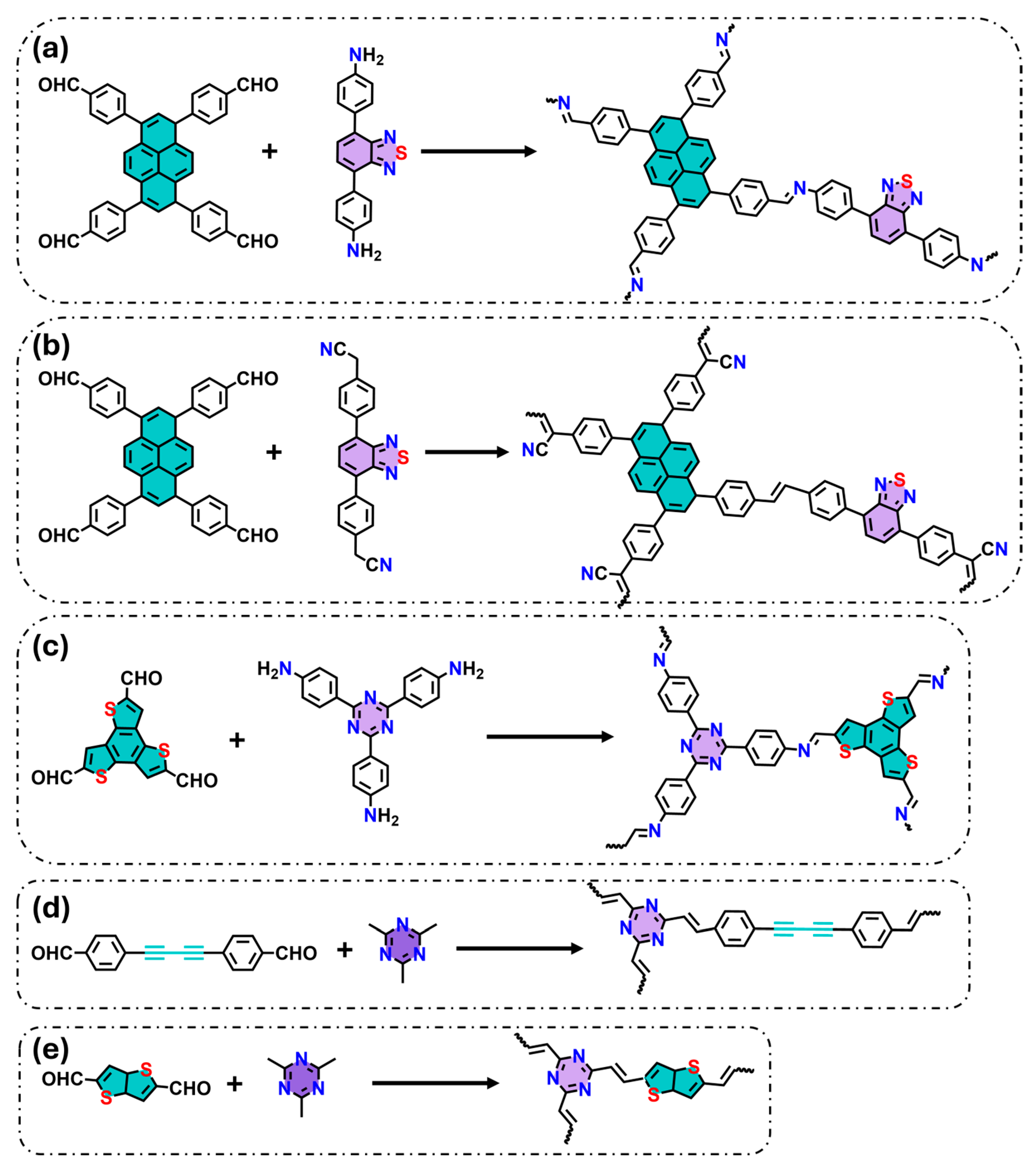
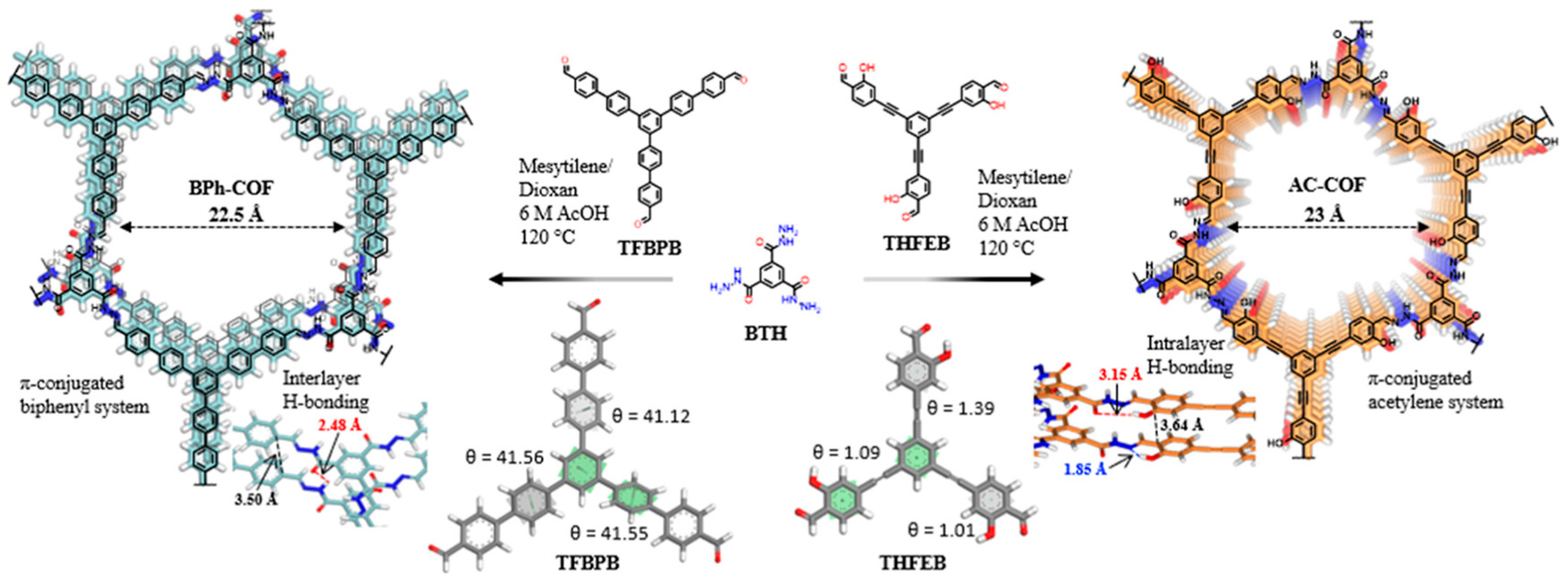
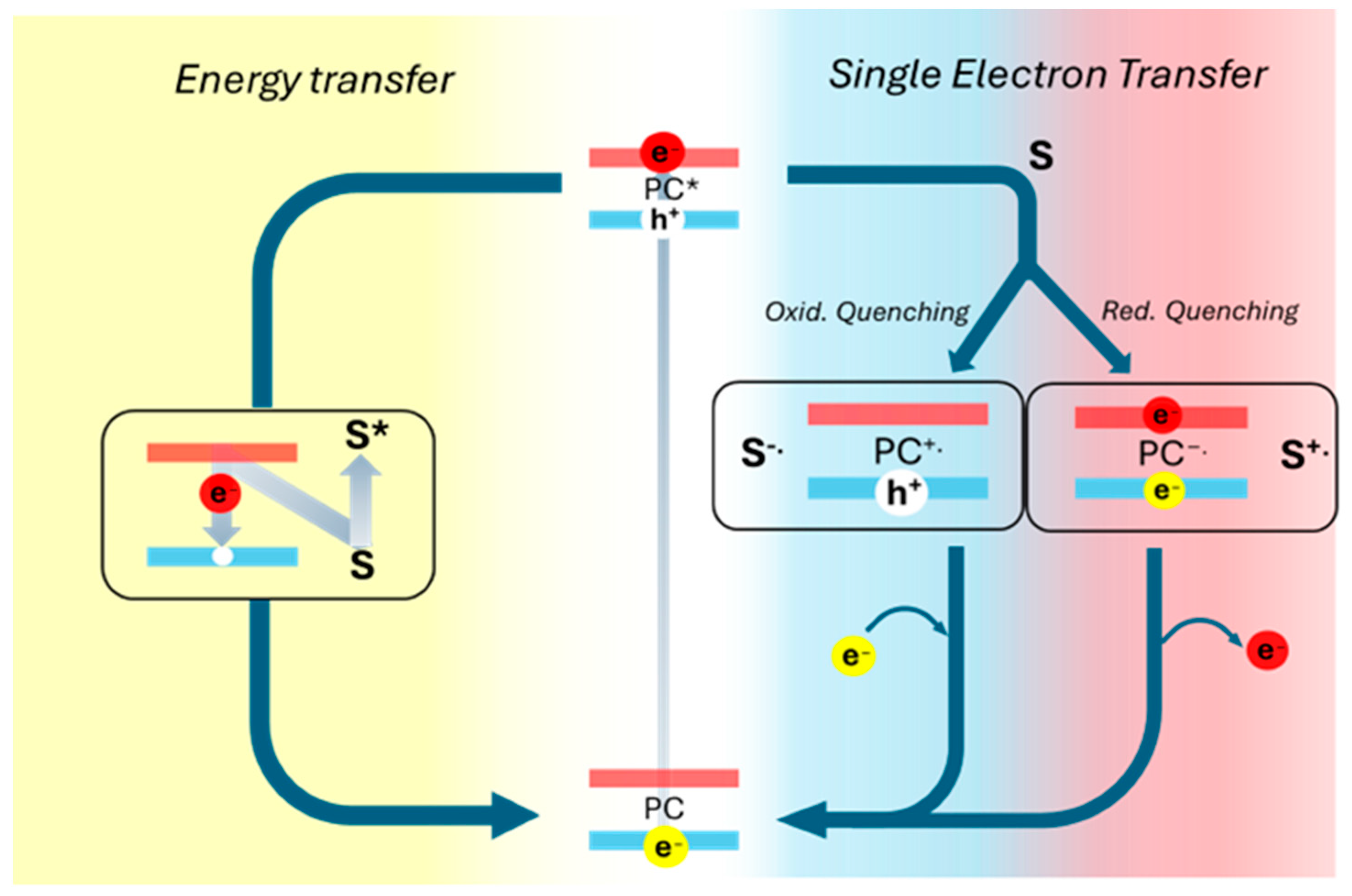

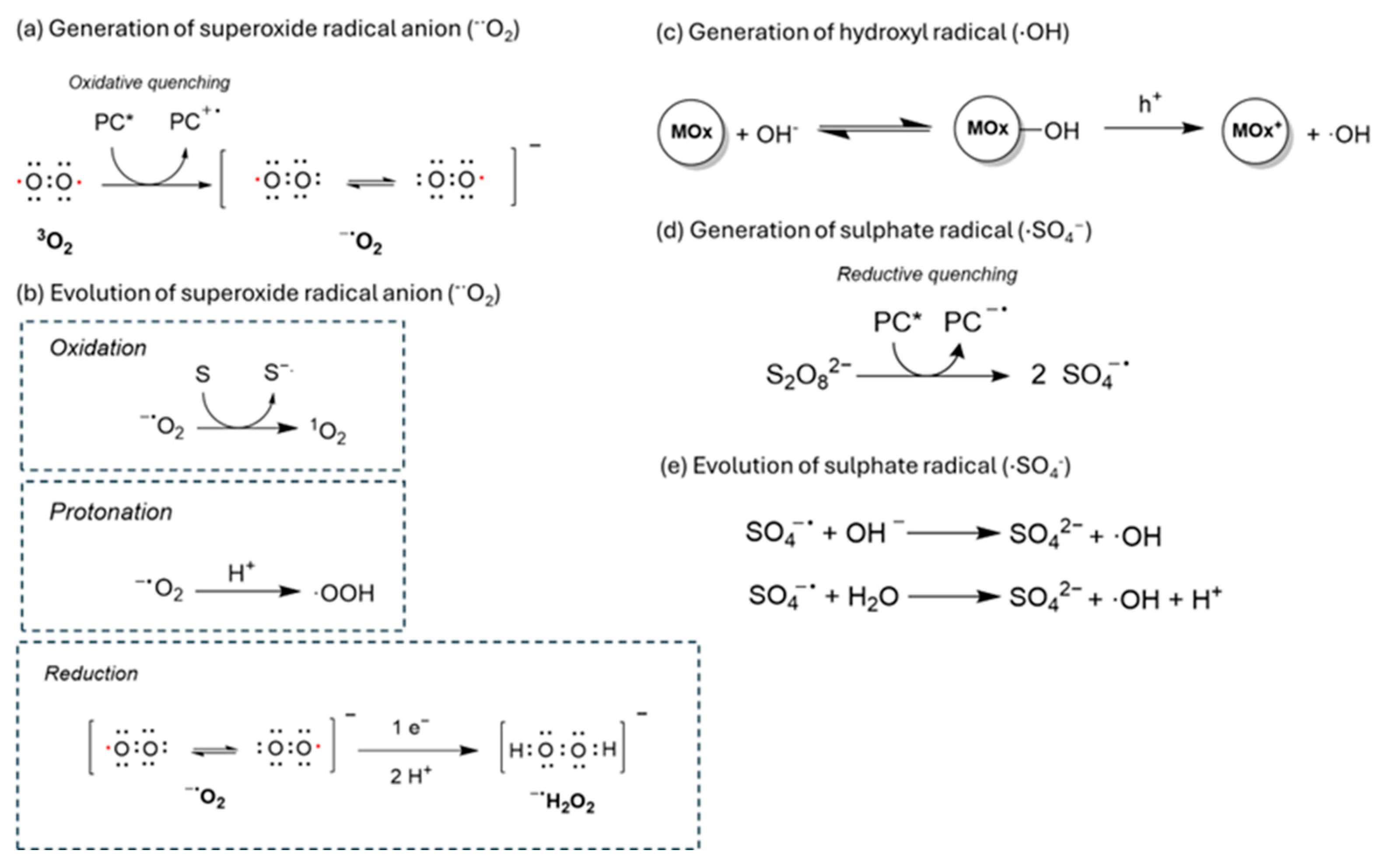
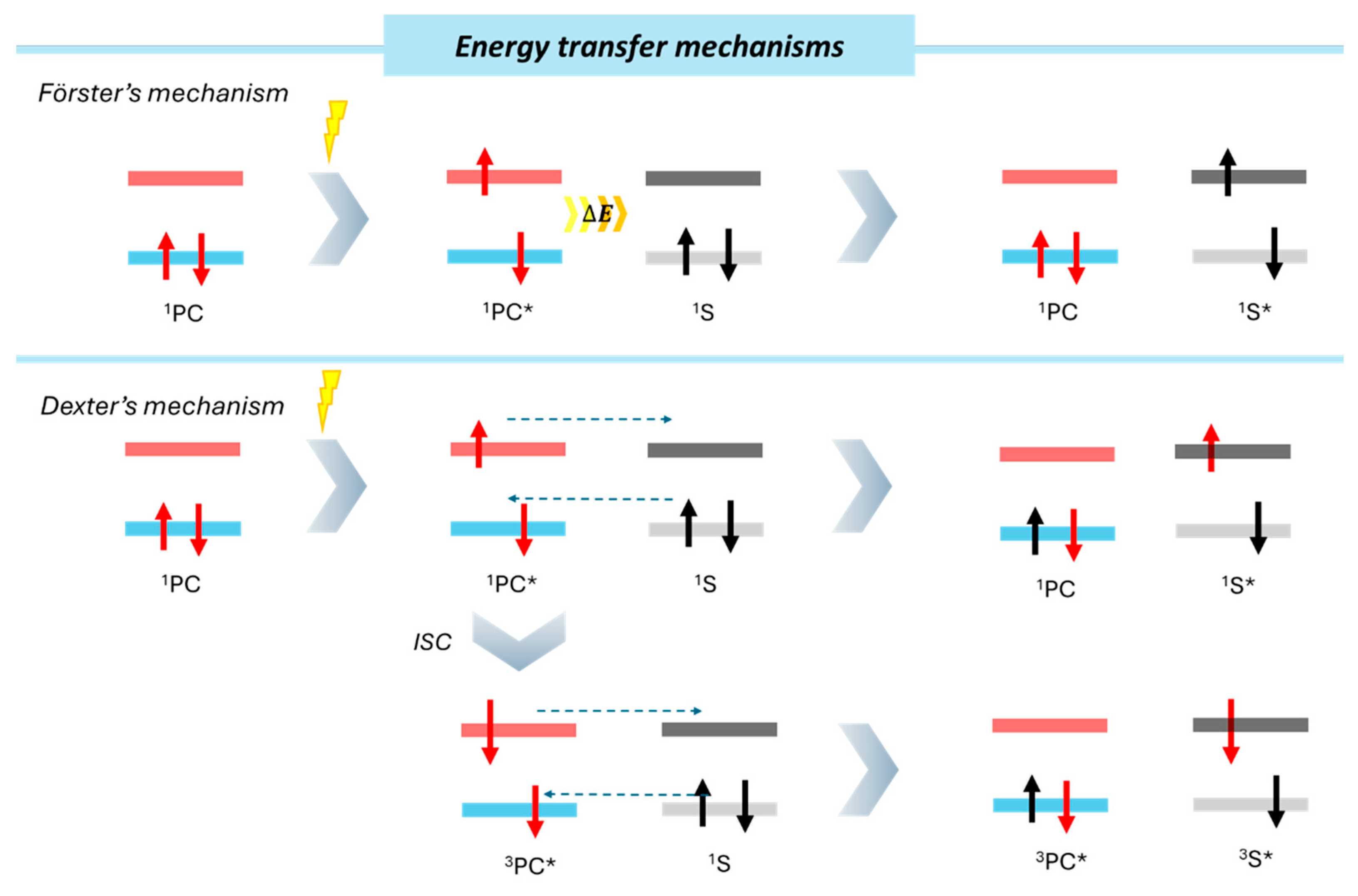

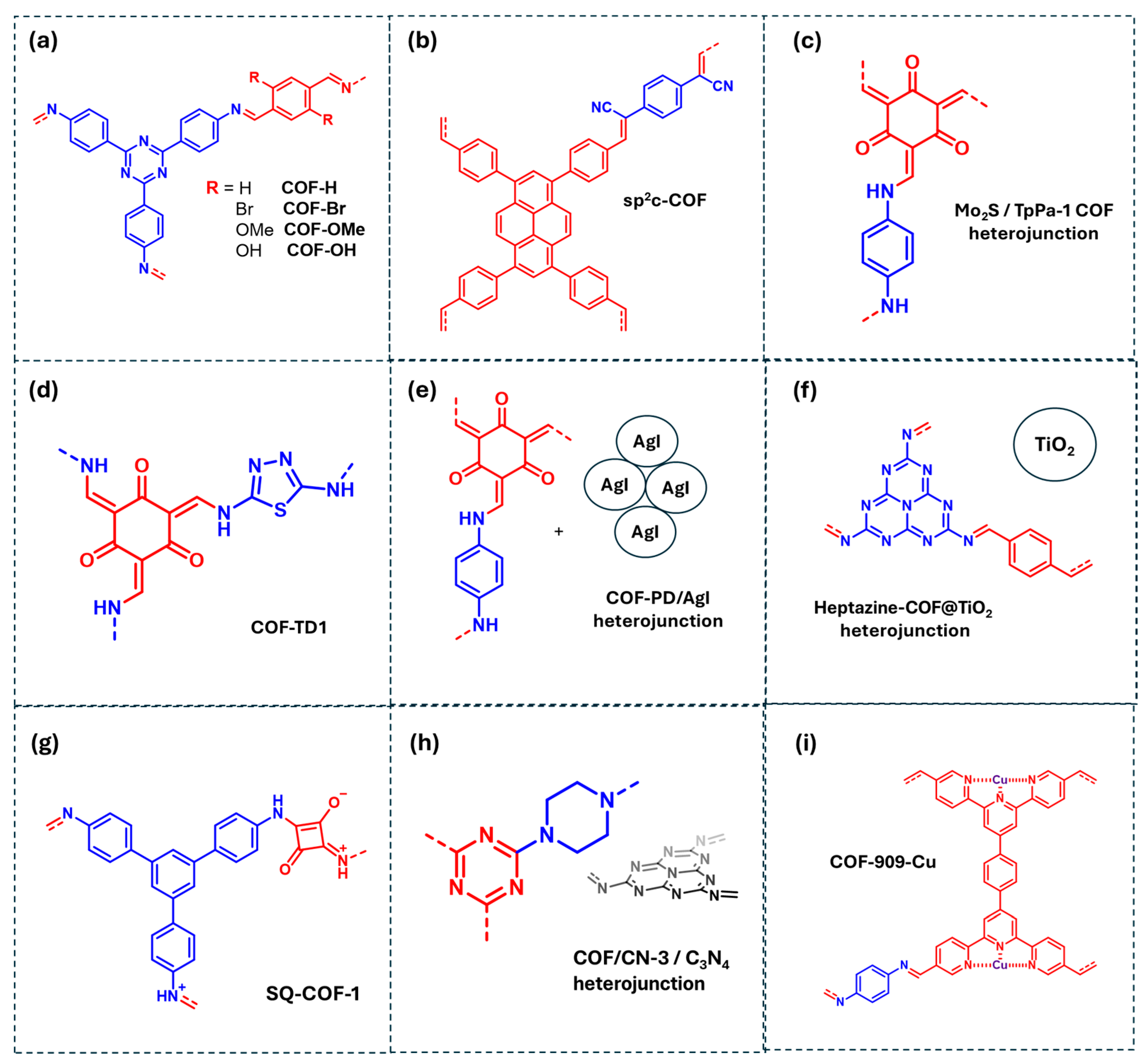
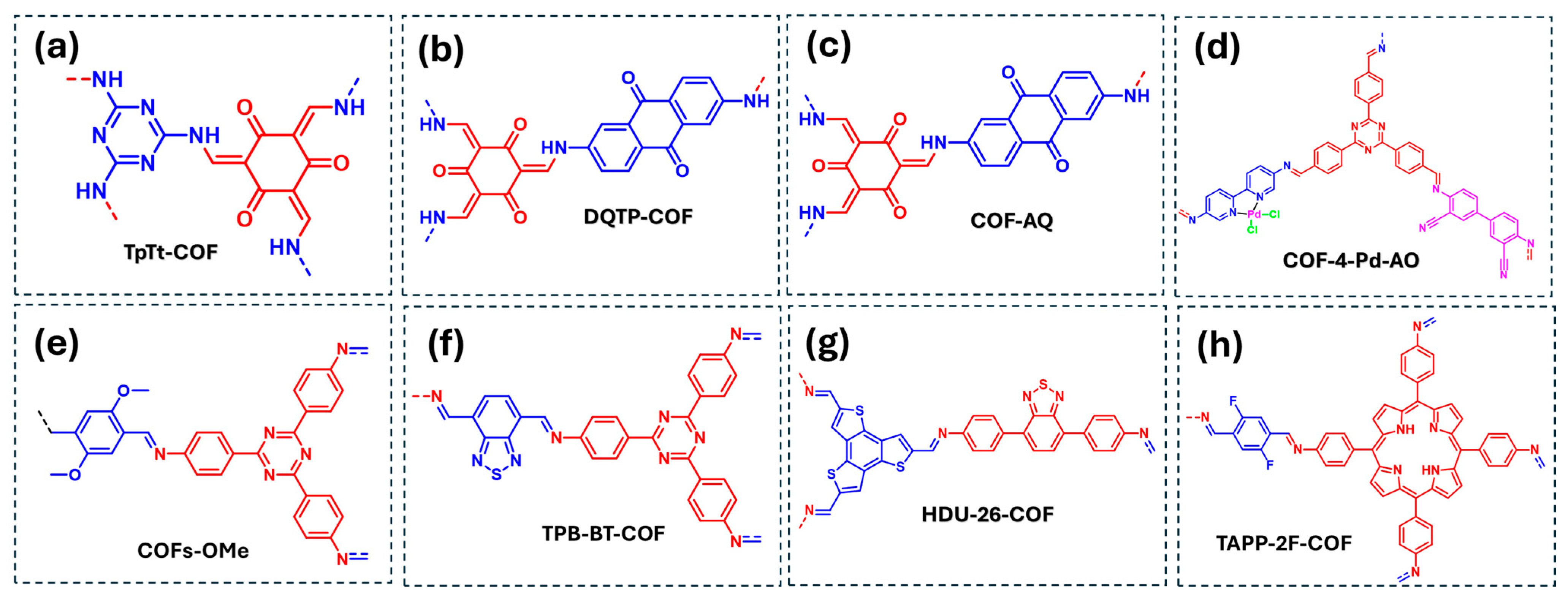
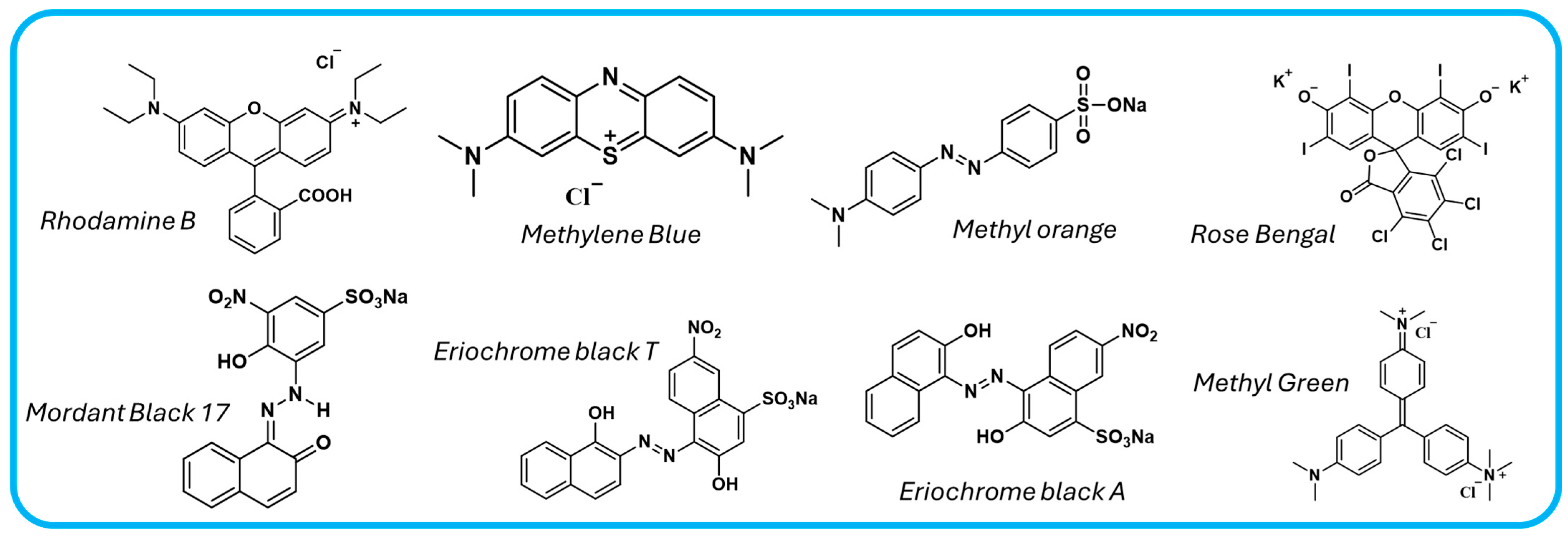
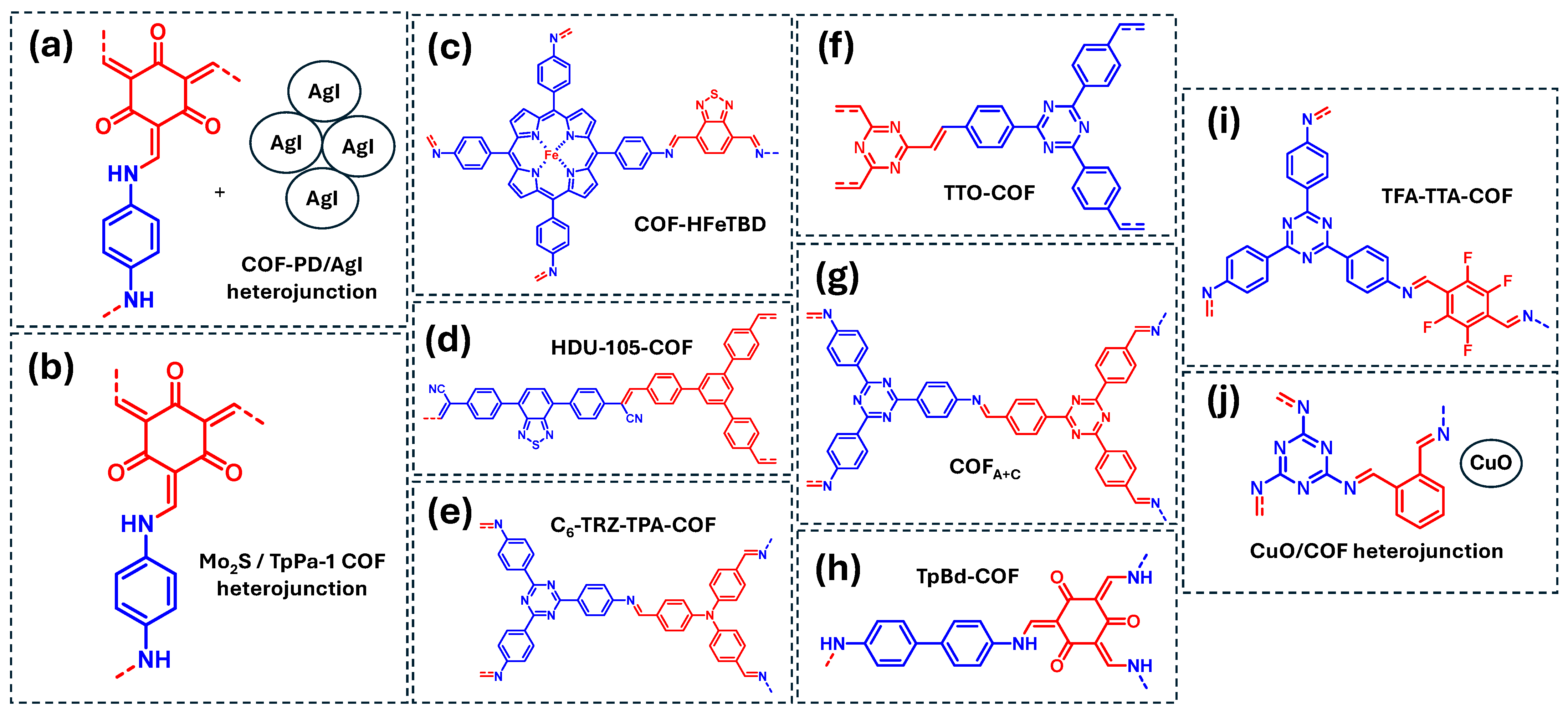

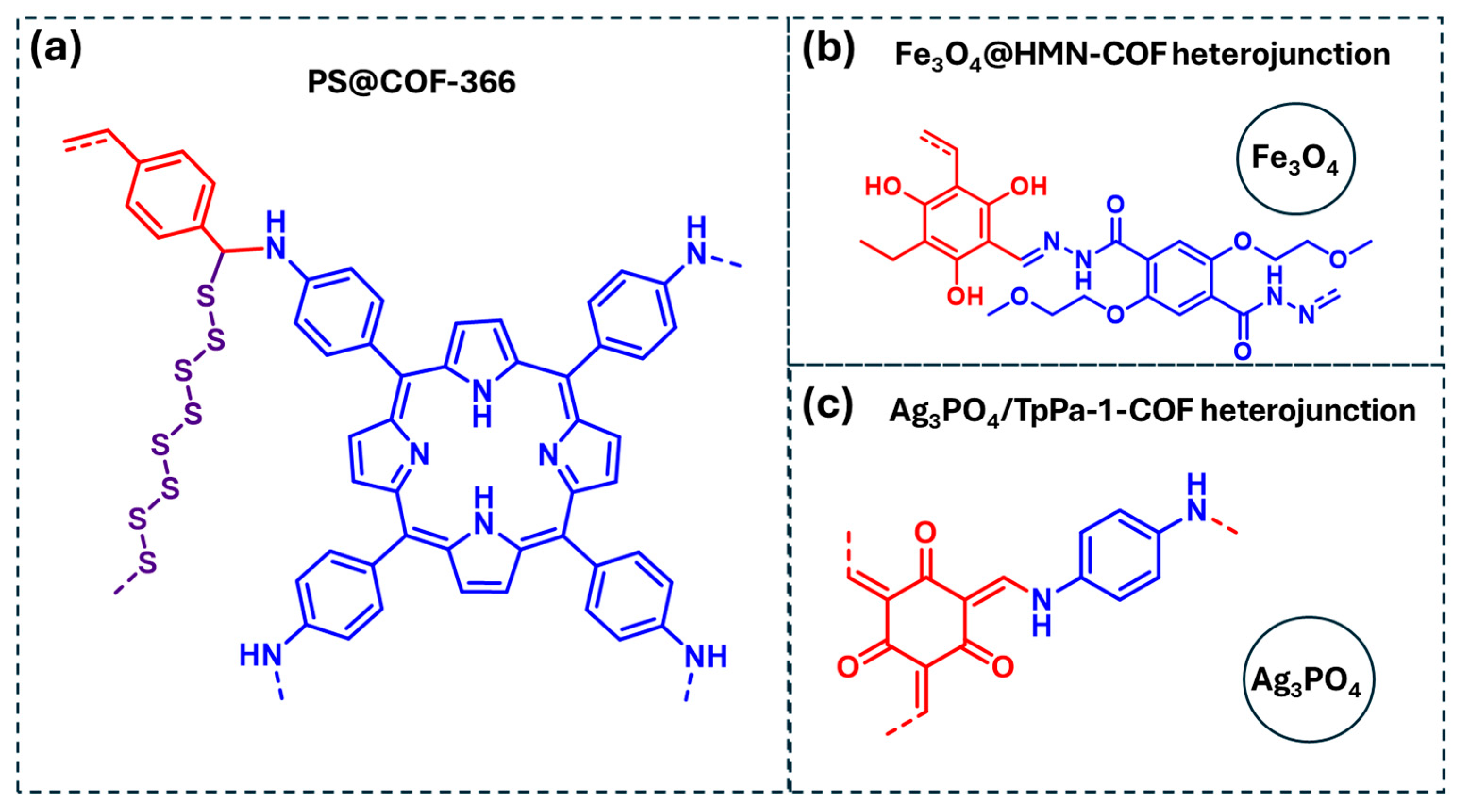

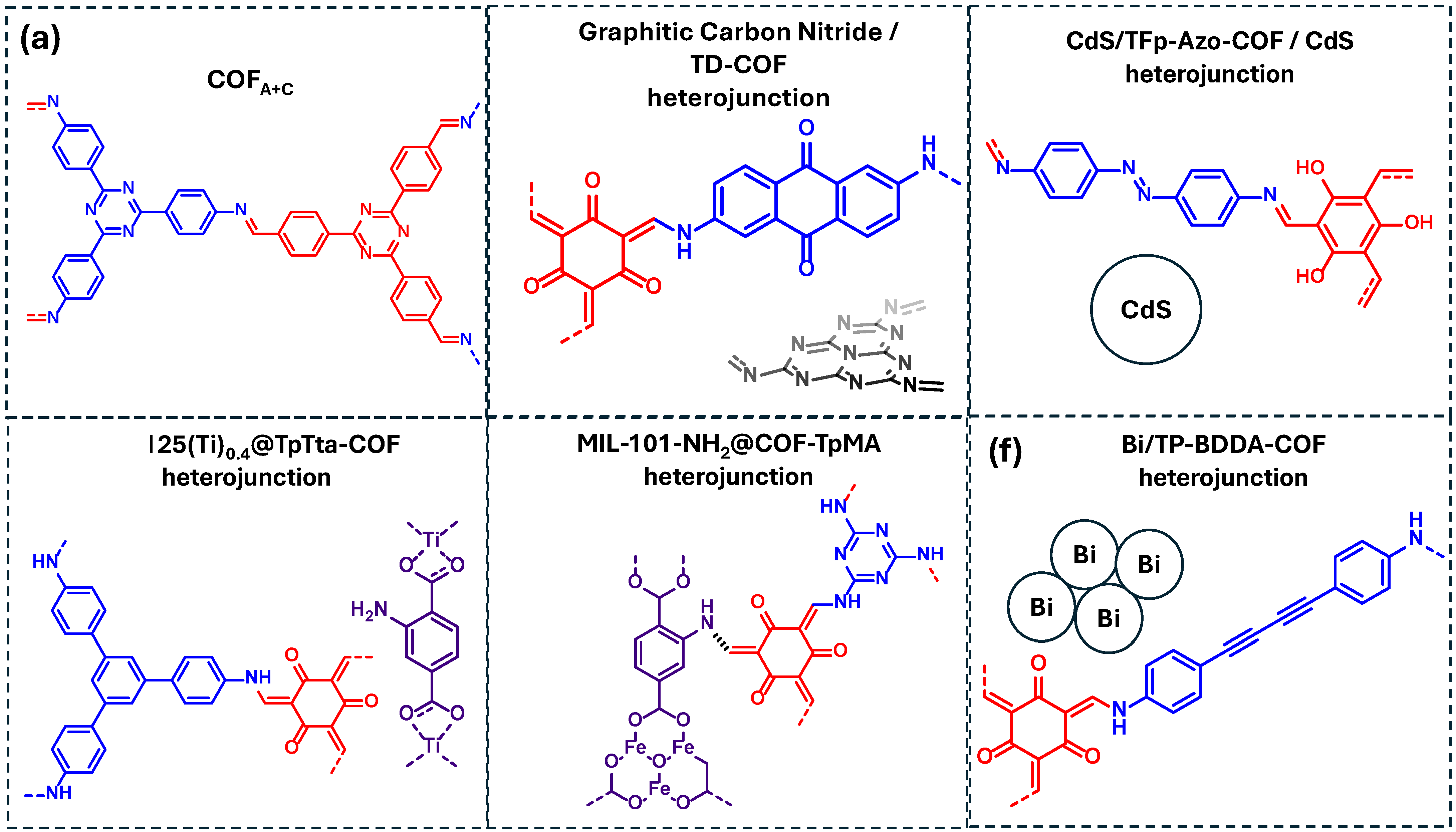
| Pollutant | COF Name (Linkage Type) | Design Principle | ROS Involved | Ref. |
|---|---|---|---|---|
| Tetracycline | COF-R (imine) | Donor–acceptor COFs | ·O2−/·OH | [70] |
| sp2c-COF (olefin) | Extended conjugation of COFs | ·OH | [71] | |
| MoS2/COF (imine) | MoS2/COF heterojunction | ·OH/·O2− | [72] | |
| Acetaminophen | COF-TD1 (imine) | Donor–acceptor COFs | ·O2− | [73] |
| COF-PD/AgI (imine) | COF/AgI heterojunction | ·O2− | [38] | |
| Heptazine-COF@TiO2 (imine) | COF/TiO2 heterojunction | ·O2− | [74] | |
| Sulfamethazine | SQ-COF-1 (imine) | Extended conjugation of COFs | ·O2− | [75] |
| COF/CN-3 (C-N bond) | COF/g-C3N4 heterojunction | ·O2−/1O2/·OH/ SO4−· | [76] | |
| Sulfamethoxazole | COF-909(Cu) (imine) | COF(Cu) | ·O2−/·OH | [77] |
| Pollutant | COF Name (Linkage Type) | Design Principle | ROS Involved | Ref. |
|---|---|---|---|---|
| U(VI) | TpTt-COF (imine) | Donor–acceptor COFs | ·O2− | [78] |
| DQTP-COF (imine) | Donor–acceptor COFs | ·O2− | [79] | |
| COF-AQ (imine) | Donor–acceptor COFs | - | [80] | |
| COF-4-Pd-AO (imine) | COF/Pd heterojunction | - | [81] | |
| Cr(VI) | COFs-OMe (imine) | Donor–acceptor COFs | ·O2− | [70] |
| TPB-BT-COF (imine) | Donor–acceptor COFs | - | [82] | |
| HDU-26-COF (imine) | Donor–acceptor COFs | ·O2− | [83] | |
| TAPP-2F-COF (imine) | Halogenated COFs | ·O2− | [84] |
| Pollutant | COF Name (Linkage Type) | Design Principle | ROS Involved | Ref. |
|---|---|---|---|---|
| Rhodamine B | COF-PD/AgI (imine) | COF/AgI heterojunction | ·O2− | [38] |
| MoS2/COF (imine) | MoS2/COF heterojunction | ·O2−/·OH | [72] | |
| COF-HFeTBD (imine) | Donor–acceptor COFs | 1O2 | [85] | |
| HDU-105-COF (olefin) | Donor–acceptor COFs | ·O2−/·OH | [54] | |
| Methylene blue | HDU-105-COF (olefin) | Donor–acceptor COFs | ·O2−/·OH | [54] |
| C6-TRZ-TPA COF (imine) | Donor–acceptor COFs | ·O2−/·OH | [86] | |
| TTO-COF (olefin) | Extended conjugation of COFs | ·O2− | [87] | |
| Methyl orange | TTO-COF (olefin) | Extended conjugation of COFs | ·O2− | [87] |
| COFA+C (imine) | N-rich COFs | ·O2−/·OH | [88] | |
| Rose bengal | C6-TRZ-TPA COF (imine) | Donor–acceptor COFs | ·O2−/·OH | [86] |
| Mordant black 17 | TpBD-COF (imine) | Pure COF | ·O2−/1O2/·OH | [89] |
| Eriochrome black T | TpBD-COF (imine) | Pure COF | ·O2−/1O2/·OH | [89] |
| TFA-TTA-COF (imine) | Fluorinated COF | ·O2−/1O2 | [90] | |
| Eriochrome black A | TFA-TTA-COF (imine) | Fluorinated COF | ·O2−/1O2 | [90] |
| Methyl green | CuO/COF (imine) | CuO/COF heterojunction | ·O2− | [91] |
| Pollutant | COF Name (Linkage Type) | Design Principle | ROS Involved | Ref. |
|---|---|---|---|---|
| Diazinon and parathion | PS@COF-366 (imine) | Sulfured COF | ·O2−/1O2/·OH | [92] |
| Imidacloprid | Fe3O4@HMN-COF (imine) | Fe3O4/COF heterojunction | - | [93] |
| Pymetrozine | Ag3PO4/TpPa-1-COF (imine) | Ag3PO4/COF heterojunction | ·O2−/·OH | [94] |
| Pollutant | COF Name (Linkage Type) | Design Principle | ROS Involved | Ref. |
|---|---|---|---|---|
| Phenol | COFA+C (imine) | N-rich COFs | ·O2−/·OH | [88] |
| GCN/TD-COF (imine) | GCN/COF heterojunction | ·O2−/·OH | [95] | |
| Bisphenol-A | CdS/TFp-Azo-COF (imine) | CdS/COF heterojunction | ·O2−/·OH | [39] |
| NM-125(Ti)0.4@TpTta-COF (imine) | MOF/COF heterojunction | ·O2−/1O2/·OH | [36] | |
| MIL-101-NH2@COF-TpMA (imine) | MOF/COF heterojunction | ·OH/SO4−· | [63] | |
| 4-chlorophenol | Bi/TP-BDDA-COF (imine) | Bi/COF heterojunction | ·O2−/·OH | [96] |
Disclaimer/Publisher’s Note: The statements, opinions and data contained in all publications are solely those of the individual author(s) and contributor(s) and not of MDPI and/or the editor(s). MDPI and/or the editor(s) disclaim responsibility for any injury to people or property resulting from any ideas, methods, instructions or products referred to in the content. |
© 2025 by the authors. Licensee MDPI, Basel, Switzerland. This article is an open access article distributed under the terms and conditions of the Creative Commons Attribution (CC BY) license (https://creativecommons.org/licenses/by/4.0/).
Share and Cite
Cepa-López, V.; Sánchez-Fuente, M.; Moya, A.; Mas-Ballesté, R. Recent Developments in the Use of Covalent Organic Frameworks for Photocatalytic Water Decontamination. Inorganics 2025, 13, 152. https://doi.org/10.3390/inorganics13050152
Cepa-López V, Sánchez-Fuente M, Moya A, Mas-Ballesté R. Recent Developments in the Use of Covalent Organic Frameworks for Photocatalytic Water Decontamination. Inorganics. 2025; 13(5):152. https://doi.org/10.3390/inorganics13050152
Chicago/Turabian StyleCepa-López, Víctor, Miguel Sánchez-Fuente, Alicia Moya, and Rubén Mas-Ballesté. 2025. "Recent Developments in the Use of Covalent Organic Frameworks for Photocatalytic Water Decontamination" Inorganics 13, no. 5: 152. https://doi.org/10.3390/inorganics13050152
APA StyleCepa-López, V., Sánchez-Fuente, M., Moya, A., & Mas-Ballesté, R. (2025). Recent Developments in the Use of Covalent Organic Frameworks for Photocatalytic Water Decontamination. Inorganics, 13(5), 152. https://doi.org/10.3390/inorganics13050152








